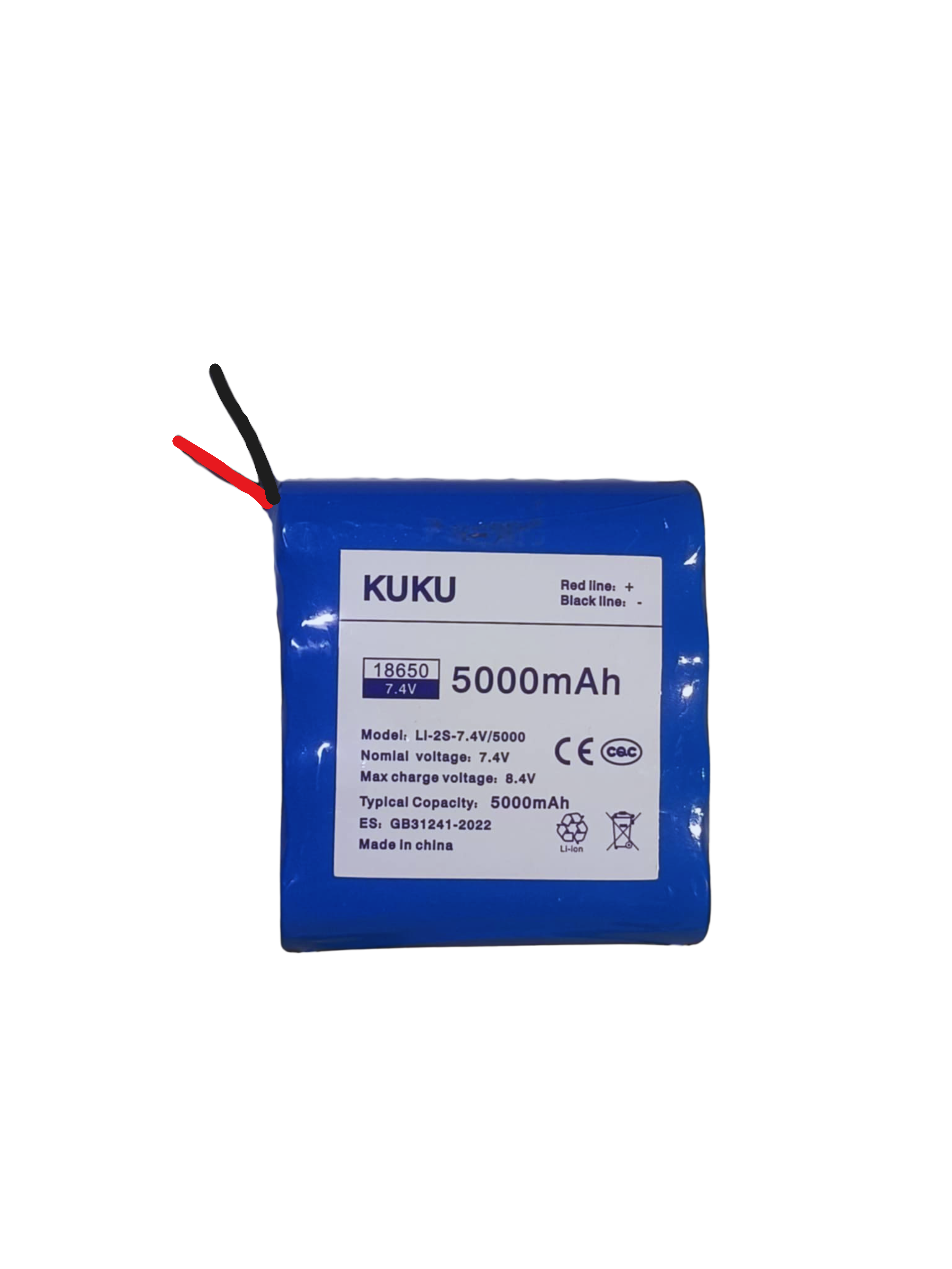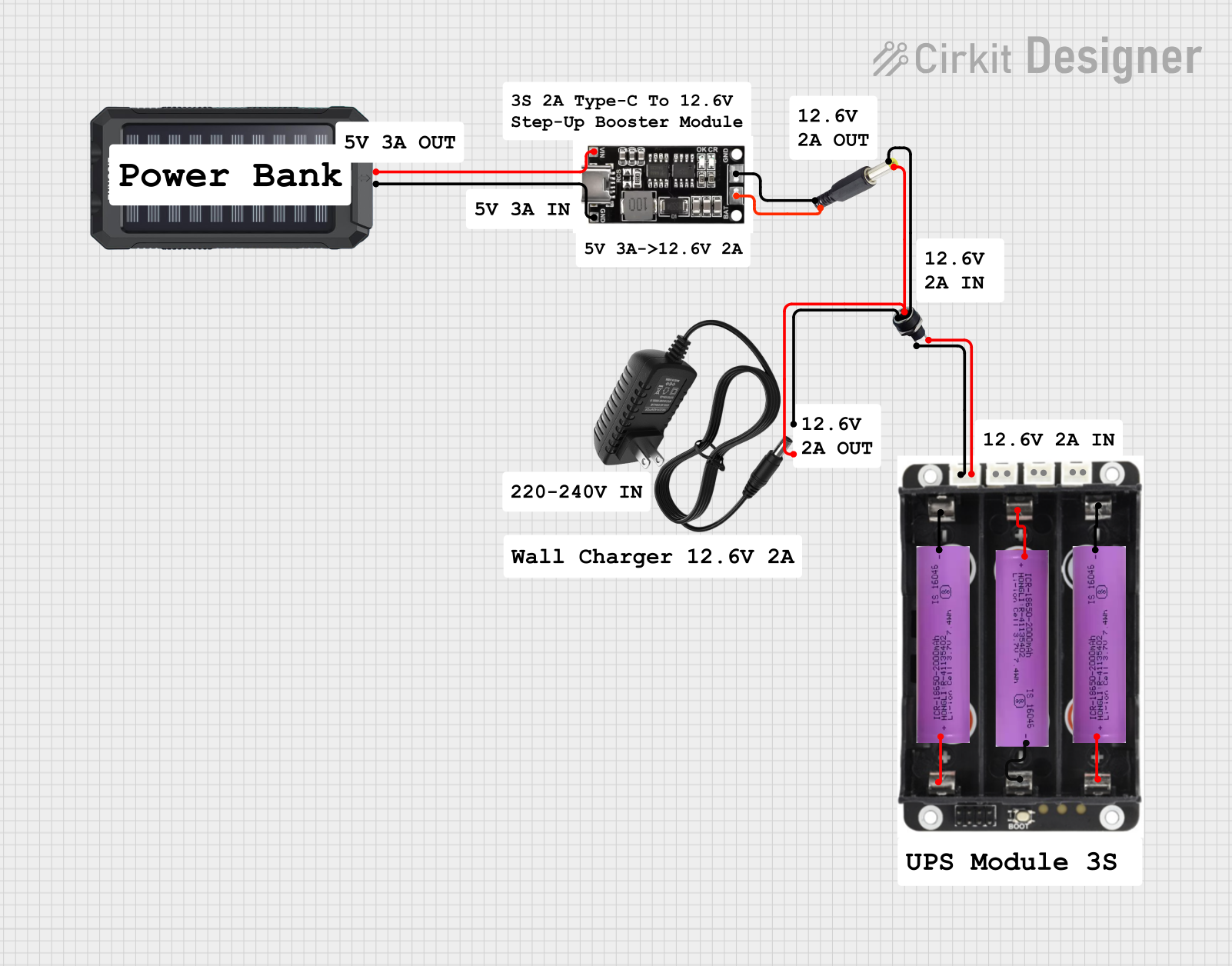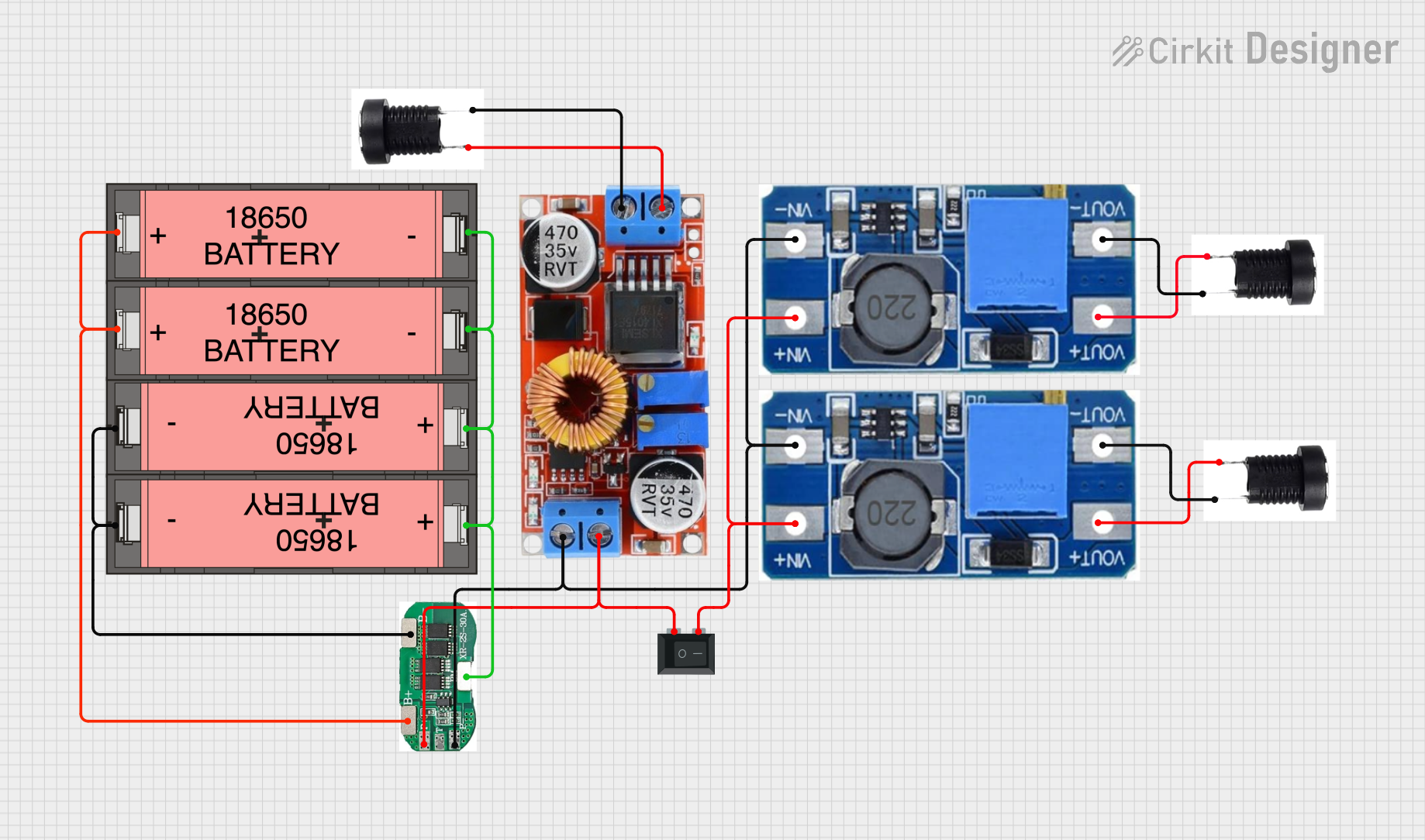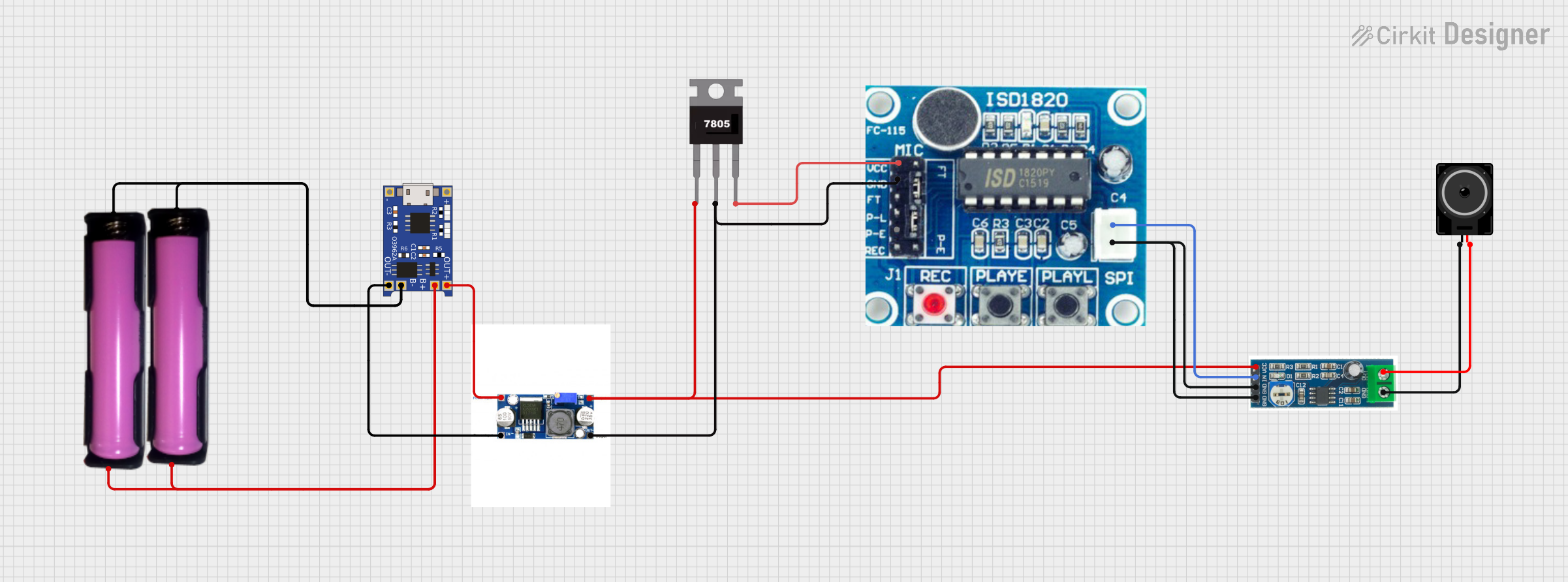
How to Use 18650 7.4V 5000mAh: Examples, Pinouts, and Specs

 Design with 18650 7.4V 5000mAh in Cirkit Designer
Design with 18650 7.4V 5000mAh in Cirkit DesignerIntroduction
The 18650 7.4V 5000mAh is a rechargeable lithium-ion battery pack, consisting of two 18650 cells connected in series. It offers a nominal voltage of 7.4V and a capacity of 5000mAh, making it ideal for applications requiring high energy density and long cycle life. This battery is widely used in portable electronics, electric vehicles, power tools, and backup power systems due to its reliability and efficiency.
Explore Projects Built with 18650 7.4V 5000mAh

 Open Project in Cirkit Designer
Open Project in Cirkit Designer
 Open Project in Cirkit Designer
Open Project in Cirkit Designer
 Open Project in Cirkit Designer
Open Project in Cirkit Designer
 Open Project in Cirkit Designer
Open Project in Cirkit DesignerExplore Projects Built with 18650 7.4V 5000mAh

 Open Project in Cirkit Designer
Open Project in Cirkit Designer
 Open Project in Cirkit Designer
Open Project in Cirkit Designer
 Open Project in Cirkit Designer
Open Project in Cirkit Designer
 Open Project in Cirkit Designer
Open Project in Cirkit DesignerCommon Applications
- Portable electronic devices (e.g., laptops, cameras, and drones)
- Electric vehicles and e-bikes
- Power tools and cordless equipment
- Backup power supplies and uninterruptible power systems (UPS)
- DIY electronics and robotics projects
Technical Specifications
The following table outlines the key technical details of the 18650 7.4V 5000mAh battery:
| Parameter | Value |
|---|---|
| Nominal Voltage | 7.4V |
| Capacity | 5000mAh |
| Chemistry | Lithium-ion (Li-ion) |
| Configuration | 2 cells in series (2S) |
| Maximum Charging Voltage | 8.4V |
| Discharge Cut-off Voltage | 6.0V |
| Maximum Discharge Current | 10A |
| Standard Charge Current | 1A |
| Dimensions (approx.) | 70mm x 38mm x 20mm |
| Weight (approx.) | 100g |
| Cycle Life | ≥500 cycles |
| Operating Temperature | -20°C to 60°C (discharge) |
| Storage Temperature | -20°C to 45°C |
Pin Configuration
The 18650 7.4V 5000mAh battery pack typically has two terminals for connection:
| Pin | Label | Description |
|---|---|---|
| 1 | + (Positive) | Positive terminal of the battery |
| 2 | - (Negative) | Negative terminal of the battery |
Usage Instructions
How to Use the Component in a Circuit
- Connection: Connect the positive terminal (
+) of the battery to the positive rail of your circuit and the negative terminal (-) to the ground rail. Ensure proper polarity to avoid damage. - Charging: Use a compatible lithium-ion battery charger with a constant current/constant voltage (CC/CV) charging profile. The charging voltage should not exceed 8.4V, and the charging current should not exceed 1A for optimal battery life.
- Discharging: Ensure the load does not draw more than the maximum discharge current (10A). Use a battery management system (BMS) to prevent over-discharge, over-current, and short circuits.
- Protection: Always use a BMS or protection circuit module (PCM) to safeguard the battery from overcharging, over-discharging, and overheating.
Important Considerations and Best Practices
- Avoid Overcharging: Overcharging can lead to overheating and potential damage. Always use a charger with a cut-off feature.
- Prevent Over-Discharge: Discharging below 6.0V can permanently damage the battery. Use a BMS to monitor voltage levels.
- Temperature Management: Avoid exposing the battery to extreme temperatures. Operate within the specified temperature range for safety and longevity.
- Storage: Store the battery in a cool, dry place at around 40-60% charge for long-term storage.
- Safety: Do not puncture, crush, or short-circuit the battery. Handle with care to prevent accidents.
Example: Using with Arduino UNO
The 18650 7.4V 5000mAh battery can power an Arduino UNO through its VIN pin. Below is an example of connecting the battery to an Arduino UNO:
Circuit Diagram
- Connect the positive terminal of the battery to the VIN pin of the Arduino.
- Connect the negative terminal of the battery to the GND pin of the Arduino.
Sample Code
// Example code to blink an LED using Arduino UNO powered by 18650 7.4V battery
const int ledPin = 13; // Pin connected to the onboard LED
void setup() {
pinMode(ledPin, OUTPUT); // Set the LED pin as an output
}
void loop() {
digitalWrite(ledPin, HIGH); // Turn the LED on
delay(1000); // Wait for 1 second
digitalWrite(ledPin, LOW); // Turn the LED off
delay(1000); // Wait for 1 second
}
Note: Ensure the battery voltage is within the acceptable range for the Arduino UNO (7-12V via VIN).
Troubleshooting and FAQs
Common Issues
Battery Not Charging
- Cause: Faulty charger or incorrect charging voltage.
- Solution: Verify the charger is compatible and outputs 8.4V with a CC/CV profile.
Battery Drains Quickly
- Cause: High current draw or aging battery.
- Solution: Check the load current and ensure it is within the battery's specifications. Replace the battery if it has reached the end of its cycle life.
Battery Overheats
- Cause: Overcharging, over-discharging, or high ambient temperature.
- Solution: Use a BMS and ensure proper ventilation. Avoid operating in extreme temperatures.
No Output Voltage
- Cause: Protection circuit triggered or battery fully discharged.
- Solution: Recharge the battery and reset the protection circuit if applicable.
FAQs
Can I use this battery for high-power applications?
- Yes, but ensure the load does not exceed the maximum discharge current of 10A.
How do I extend the battery's lifespan?
- Avoid overcharging, over-discharging, and operating in extreme temperatures. Store the battery at 40-60% charge when not in use for extended periods.
Is it safe to connect multiple batteries in series or parallel?
- Yes, but use a BMS to balance the cells and ensure safe operation.
Can I charge the battery with a solar panel?
- Yes, but use a solar charge controller designed for lithium-ion batteries to regulate the voltage and current.
By following these guidelines, you can safely and effectively use the 18650 7.4V 5000mAh battery in your projects.